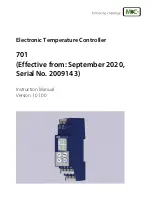
[lolsbere-130511-01.tif, 1, en_US]
Figure 7-49
Cyclic Reclosing Function: Logic for the Circuit-Breaker Readiness
The automatic reclosing function uses the information from the circuit breaker for the following purposes (see
):
•
Detection of a non-closed circuit breaker before the start:
In idle state of the automatic reclosing function, a non-3-pole closed circuit breaker leads to the blocking
of the automatic reclosing function, see also chapter
. This monitoring is not needed if
the auxiliary-contact signals are not available.
•
Detection of the reaction of the circuit breaker after a trip command:
The automatic reclosing function dead time is started immediately with the opening of the circuit breaker
if the circuit-breaker auxiliary contacts are connected. Here a decision is made based on the opening of
the circuit breaker if the circuit breaker is no longer 3-pole closed.
An exception is the reaction to an evolving fault. As the circuit breaker already has 1 pole open before the
occurrence of an evolving fault, the dead time is started if the circuit breaker is detected as having 3
poles open.
If the circuit-breaker auxiliary contacts are not connected, the automatic reclosing function dead time will
start with the dropout of the operate indication.
•
After a 1-pole trip, a check is done during the dead time to determine whether the circuit-breaker poles
that were not switched off remain closed. The circuit-breaker position recognition is delivered from the
central circuit-breaker position recognition of the Circuit-breaker function group.
For implausible circuit-breaker condition, a 3-pole trip command synchronization for the circuit breaker is
executed provided the settings allows this. After this 3-pole tripping, if set and not blocked, more 3-pole
automatic reclosing cycles may follow, see also chapter
7.2.4.11 Dead Time for Operating Modes With
.
Protection and Automation Functions
7.2 Automatic Reclosing Function
570
SIPROTEC 5, High-Voltage Bay Controller, Manual
C53000-G5040-C015-9, Edition 11.2017
Summary of Contents for 6MD85
Page 8: ...8 SIPROTEC 5 High Voltage Bay Controller Manual C53000 G5040 C015 9 Edition 11 2017 ...
Page 30: ...30 SIPROTEC 5 High Voltage Bay Controller Manual C53000 G5040 C015 9 Edition 11 2017 ...
Page 46: ...46 SIPROTEC 5 High Voltage Bay Controller Manual C53000 G5040 C015 9 Edition 11 2017 ...
Page 172: ...172 SIPROTEC 5 High Voltage Bay Controller Manual C53000 G5040 C015 9 Edition 11 2017 ...
Page 514: ...514 SIPROTEC 5 High Voltage Bay Controller Manual C53000 G5040 C015 9 Edition 11 2017 ...
Page 1056: ...1056 SIPROTEC 5 High Voltage Bay Controller Manual C53000 G5040 C015 9 Edition 11 2017 ...
Page 1092: ...1092 SIPROTEC 5 High Voltage Bay Controller Manual C53000 G5040 C015 9 Edition 11 2017 ...
Page 1204: ...1204 SIPROTEC 5 High Voltage Bay Controller Manual C53000 G5040 C015 9 Edition 11 2017 ...
Page 1238: ...1238 SIPROTEC 5 High Voltage Bay Controller Manual C53000 G5040 C015 9 Edition 11 2017 ...
Page 1252: ...1252 SIPROTEC 5 High Voltage Bay Controller Manual C53000 G5040 C015 9 Edition 11 2017 ...
Page 1256: ...1256 SIPROTEC 5 High Voltage Bay Controller Manual C53000 G5040 C015 9 Edition 11 2017 ...
















































